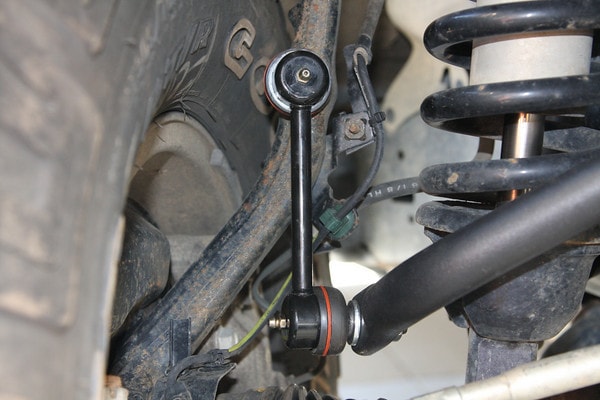Almost every vehicle on the road has a sway bar on the front and rear suspensions to help keep the vehicle upright and stable when going around corners. It can also be called an anti-sway bar, a stabilizer bar, a roll bar, or an anti-roll bar. A sway bar is usually a solidly formed bar of spring steel that resists twisting and is bolted across the front and rear of a vehicle’s frame or subframe. Sway bar links connect the two ends of each sway bar to suspension components, so there is one sway bar link for each corner. Usually the links will have a ball socket with a stud that goes through a hole, which is then fixed down by a single bolt on each end.
The principle of operation is that when going around a corner, the body of a vehicle will tend to roll, which pushes down one side of the vehicle and lifts the other. A sway bar will resist that roll, requiring the bar to be twisted for one side to raise or lower independently of the other; the sway bar allows a vehicle to corner and steer while staying upright and stable. Different diameter sway bars are more or less resistant to roll forces. The connecting links tend to be lower down on the suspension and are therefore susceptible to corrosion and physical damage, as well as the normal wear and tear of a working suspension piece.
Most of the time, in theory, the sway bar links are easily accessible and not too much trouble to replace. In practice, though, the nuts that hold them in place are self-locking, and if they’ve been on for a while or if there is rust, they can put up a fight. Knowing that, it’s common if they are being replaced for them to be cut off rather than engaging in a struggle with half-frozen fastening bolts.
Costs of Sway Bar Link Replacement
On most vehicles, it costs about $150 to replace a pair of sway bar links, either on the front or rear of the vehicle.
For some more specific sway bar link replacement cost estimates on some common vehicles, using $150 an hour as a labor rate:
For a 1999 Chevrolet Tahoe, the labor time to replace the two front sway bar links is .5 of an hour. A pair of factory links costs about $91, or TRW parts cost about $40. That makes the job about $166 using OE parts, or about $115 using aftermarket parts.
For a 2006 Honda Accord, the labor time to replace the front sway bar links is .8 of an hour. A pair of factory links costs about $62, or Delphi links cost about $44. This makes the job about $182 using OE parts, or about $164 using aftermarket parts.
For a 2004 Jeep Grand Cherokee, the labor time to replace the front sway bar links is .5 of an hour. A pair of factory links costs about $316, or a pair of Delphi links costs about $52. This makes the job about $391 using OE parts, or about $127 using aftermarket parts.
In most cases, the costs and time involved are about the same on the rear of the vehicle as on the front.
What Are Indications that Sway Bar Links Need Replaced?

If a sway bar is broken, then it should be noticeable through poor handling in corners. A broken sway bar link can interfere with parts of the suspension and make noise going over bumps or around corners. If that’s the problem, a visual inspection should be enough to figure it out.
On each end of a sway bar link, there is either a bushing or a ball-socket. Both can wear out and cause noise. If a worn bushing or ball socket is the problem, it would show up as a noise going around corners or when the vehicle is rocked back and forth, and sometimes going over bumps as well. A worn out bushing-style socket is usually obvious, but a ball-socket style link is a little harder to diagnose, though the symptoms would be identical – noise when going around corners or bumps, or when the vehicle is rocked. To diagnose a ball-socket link, usually a vehicle is put up in the air and the links are knocked upward with a rubber mallet to see if they are loose and making noise.
FAQ
There are almost always four, one on each corner.
They are a part that’s under a lot of stress, but they can last indefinitely. Hard cornering may be what causes the most wear, but there’s no special way to predict or prevent a sway bar failure. They make themselves known if they need to be replaced.
Yes, as long as it is understood that cornering performance will be compromised. Just as the engine has a “limp mode” for when all the cylinders aren’t performing, if a vehicle is driven mildly and with care when a suspension part is compromised it can be safe.
Generally not. In this case, the part is very simple and low tech; there is little advantage to using a factory part, and little risk in using any name brand aftermarket part.
Moderately difficult. They look like they should be easy, but rusted or frozen up hardware is very common and cutting tools or special techniques are often required.
In designs where that might be an option, a poly link might be longer lasting. The trade-off with polyurethane is that it’s a little stiffer than rubber and transmits more noise, but that doesn’t really cause any issues with a sway bar link.
No, the sway bar links have no impact on wheel alignment.
